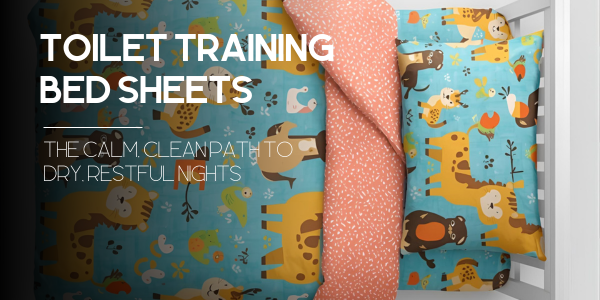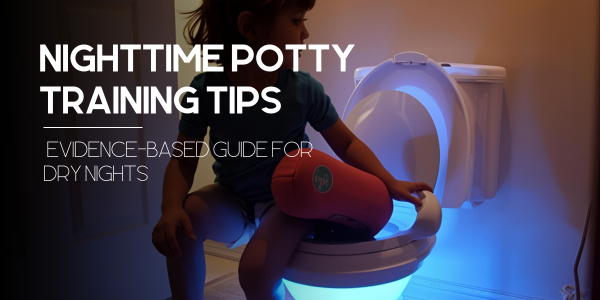8 Year Old Bed Wetting Isn't Failure—It’s Development. Here’s How to Help
Picture this: It’s 10 p.m., and your 8-year-old drifts off with a hug and a kiss goodnight. An hour later, you sense something amiss. The familiar dampness greets you, and your heart tugs with empathy. Bed wetting at age eight is more common than most parents realize, but it remains shrouded in hushes and hidden shame. In this blog, we shatter silence and light a path forward for families navigating 8-year-old bed wetting.
At Chooniez, we believe every child deserves dignity, and every parent deserves practical guidance. This article isn’t a sterile checklist—it’s a carefully crafted companion for your family’s journey. From understanding why bed wetting happens at this stage to compassionate strategies that build self-esteem, we’ll walk alongside you, weaving medical insights, emotional support, and innovative solutions into a cohesive, forward-thinking roadmap.
Why This Blog Matters
Many parents wrestle with guilt or embarrassment when their 8-year-old still has nighttime accidents. Meanwhile, children may internalize those moments as personal failures. Our goal? To replace shame with awareness, fear with actionable steps, and isolation with community. In doing so, we hope to elevate Chooniez’s credibility as thought leaders in pediatric incontinence—championing the notion that conversations around bed wetting should be open, forward-thinking, and solution-driven.
SEO best practices inform our approach: we’ll spotlight high-traffic queries like “8 year old bed wetting,” “nocturnal enuresis in children,” and “support for nighttime accidents”, strategically weaving them throughout to ensure families find this guide when they need it most.
Blog Roadmap
Here’s what you can expect in the sections ahead:
- Understanding 8-Year-Old Bed Wetting: Definitions, prevalence, and myths dispelled.
- Emotional Impact & Support: Building resilience for both child and parent.
- Medical & Professional Insights: When to seek help and proven treatment options.
- Practical Management Strategies: Bedtime routines, protective bedding, and lifestyle tweaks.
- Innovative, Forward-Thinking Solutions: From smart alarms to integrative therapies.
- Chooniez’s Thought Leadership: Case studies, expert collaborations, and comprehensive resources.
In this first installment, we dive into “Framing the Conversation: Understanding 8-Year-Old Bed Wetting.” Let’s break down terminology, normalize the experience, and equip you with the questions every parent and child asks when facing nighttime accidents.
Framing the Conversation: Understanding 8-Year-Old Bed Wetting
Defining the Terms
Bed wetting, clinically known as nocturnal enuresis, simply means involuntary nighttime urination after an age when it’s expected a child can stay dry. At eight years old, your child’s bladder is still maturing. In some cases, this is primary enuresis—they’ve never consistently stayed dry overnight. In others, it’s secondary enuresis, where dryness was achieved but regressed due to factors like stress or illness. Neither form is a reflection of laziness or misbehavior.
To further demystify the topic, you might explore our positive, forward-thinking guide for bedwetting in children, which dives deeper into the semantics and first steps for compassionate conversations at home.
Prevalence & Normalization
You may be surprised to learn that around 10–15% of eight-year-olds experience nighttime accidents periodically. Instead of isolation, view this as a shared milestone—a stage many children pass through. Recognizing “bed wetting at age 8” as a typical developmental detour can deflate guilt and help your child feel less singled out. Startling statistics can offer relief: a significant percentage of children continue to have occasional accidents until age nine or even ten. These numbers are backed by pediatric associations, reassuring families that they’re in good company.
Normalization is a powerful antidote to shame. When parents speak openly—“I understand this is frustrating, but it’s common and treatable”—children often respond with relief rather than embarrassment. This empowers them to participate in solutions rather than retreat in silence.
Common Myths & Misconceptions
Myth: “All kids stop wetting the bed by age 7.”
Reality: Bladder control timelines vary. Many children, even at age eight, are still developing neuromuscular coordination. Genetic factors often play a role—if one parent wet the bed past age eight, there’s a 70% chance the child might too.
Myth: “Bed wetting at 8 is always psychological.”
Reality: While emotional stress can trigger accidents, the primary cause is often physiological—delayed maturation of the brain–bladder signaling system or a smaller-than-average bladder capacity at night. Psychological factors are one piece of a multifactorial puzzle.
Myth: “Punishment helps prevent bed wetting.”
Reality: Punishing a child for something they cannot control only breeds shame and anxiety, which in turn exacerbate bed wetting. Instead, a supportive, solution-focused approach—celebrating dry nights and reviewing routines—yields far better results.
Key Questions Parents & Kids Ask
- “Is 8-year-old bed wetting normal?” Yes—about one in seven eight-year-olds still have occasional accidents.
- “Why is my 8-year-old wetting the bed?” Potential causes range from delayed bladder maturation to deep sleep patterns, genetics, or lifestyle factors like fluid intake timing.
- “When should I seek medical help for my child’s nighttime accidents?” If bed wetting continues consistently past six months, or if daytime accidents occur, consulting a pediatrician is wise.
- “How do I talk to my child about incontinence without causing shame?” Emphasize: “This is not your fault—your body is still learning.” Detail topics like bathroom scheduling and hygiene in age-appropriate terms.
These questions set the stage for our deeper dive into emotional support, clinical advice, and innovative solutions. But first, let’s pause to acknowledge that understanding and empathy are the bedrock of any effective strategy. By reframing bed wetting as a developmental phase rather than a failure, families can shift from frustration to proactive, positive action.
Protect Your Child’s Confidence
Ready to invest in bedtime peace of mind? Our bed-wetting throw blanket is designed with ultra-absorbent layers that keep mattress moisture-free and anxiety at bay. Say goodbye to midnight panic and hello to dry, worry-free mornings.
Shop the Bed-Wetting BlanketThe Science & Psychology Behind Bed Wetting at Age 8
Physiological Factors
Beneath the surface of every nighttime accident lies a web of physiological mechanics still under construction. At eight years old, a child’s bladder is often smaller than it needs to be for a full night’s sleep, and the kidneys may continue producing urine at adult-like volumes even as the brain–bladder communication pathways are refining their signals. Simply put, your child’s body may not yet be wired to recognize a full bladder before deep slumber sets in.
Think of this process like tuning a musical instrument: neural signals must synchronize perfectly with bladder capacity. Some children have a genetic blueprint that delays bladder maturation; if one parent experienced bed wetting past age eight, the odds double that their child might too. Fortunately, breakthroughs in pediatric urology and nocturnal enuresis research are paving the way for tailored solutions. Check out our detailed overview of innovations in bedwetting technology to learn how science is helping families sleep sounder, night after night.
Developmental & Neurological Considerations
Your child’s brain is still learning how to balance sleep depth with bladder awareness. During deep sleep—especially the slow-wave stages—signals that typically notify the brain of a full bladder can be muffled or delayed. In effect, a deep sleeper might not register the need to wake up and use the bathroom. When neural pathways governing bladder control take longer to mature, bed wetting can persist well into the elementary school years.
Researchers have discovered that some children exhibit delayed neural myelination in pathways connecting the pontine micturition center to the cerebral cortex. In layperson’s terms, the “wires” responsible for saying “Hey, wake up!” simply haven’t insulated fully. While this neurological nuance may sound daunting, it also means that with targeted interventions—like timed voiding and bladder-stretching exercises—the communication lines can strengthen over time.
Psychological & Emotional Triggers
Bed wetting isn’t solely a matter of bladder size or brain wiring. Emotional upheaval—whether big or small—can act as a trigger. An upcoming school play, a new sibling, or a recent move can create stress hormones that interfere with nighttime bladder control. Some kids internalize worries so deeply that their bodies react involuntarily during sleep.
A gentle, empathetic approach can defuse this cycle of anxiety. For example, framing each night as a fresh opportunity, rather than a test that must be passed, removes performance pressure. If you’re looking for tips on navigating these conversations, our forward-thinking guide on how to talk to kids about bed wetting offers age-appropriate scripts and confidence-building prompts that transform fear into empowerment.
Environmental & Lifestyle Contributors
It’s not just the body and mind working against dryness—environmental and lifestyle factors also play a pivotal role. Late-night drinks of soda or chocolate milk, especially within two hours of bedtime, can increase bladder irritation. Similarly, caffeine-laden snacks (hello, chocolate chip cookies) might wake little kidneys into action. By adjusting fluid intake—encouraging water-rich foods earlier in the day and tapering liquids in the evening—you can significantly reduce nighttime bladder volume.
The bedroom environment matters, too. A dim nightlight can help your child navigate a midnight dash to the bathroom, minimizing disruption. Reinforce a consistent bedtime routine: a final bathroom trip, quiet reading or journaling, and gentle breathing exercises. Such habits not only signal to the body that it’s time to slow down, but they also train the bladder to hold gradually larger volumes—like gently stretching a rubber band so it holds more tension without snapping.
Emotional Impact & Building Resilience
For the Child: From Embarrassment to Empowerment
Imagine lying in bed, heart pounding, as you realize your sheets are wet. Embarrassment washes over you—maybe worse than the cold dampness. For a child, these moments can feel catastrophic. But what if that very incident became a stepping stone toward self-confidence? By reframing each morning not as a failure, but as an opportunity to learn, you can transform shame into resilience.
Start with empathetic language: “I know you feel upset, but your body is still learning.” Acknowledge emotions without judgment. Create a bedtime mantra—something simple like, “I am safe, I am capable, tomorrow will be better.” Over time, this positive self-talk weaves new neural pathways that replace self-criticism with self-assurance.
Encourage your child to participate in small, celebratory rituals: placing a dry-night sticker on a chart, choosing a special bedtime story, or picking out pajamas that make them feel brave. Each tiny victory builds momentum. And on nights that don’t go as planned, remind them that growth often comes in waves. With a supportive framework, embarrassment recedes and empowerment takes root.
For Parents: From Frustration to Compassionate Support
Parents often oscillate between worry, guilt, and frustration—wondering, “Am I doing enough?” It’s natural to feel flustered, but pushing frustration onto your child only deepens the cycle. Instead, lead with compassion. Reflect: “How would I feel if I were in their shoes?” By remembering your own childhood vulnerabilities, you can soften your tone and pivot from reprimand to reassurance.
Effective communication stems from active listening. When your child voices fears—“I hate waking up soaked!”—validate: “I understand. That must feel embarrassing.” Then offer tangible solutions: “Let’s try a new routine tonight and see how it feels.” By positioning yourself as a co-ally in the journey, you dismantle barriers of shame and replace them with teamwork.
It’s also vital to address any parental self-blame. If you catch yourself thinking, “I should have stopped this earlier,” pause. Bed wetting at eight is seldom a reflection of parenting prowess; it’s a developmental phase. When you exhibit calm confidence, your child senses stability—and stability is the foundation of resilience.
Family Dynamics & Sibling Considerations
In a bustling household, siblings may inadvertently become judges or bystanders. Teasing—even if meant in jest—can amplify your child’s shame. Establish clear family guidelines: no mocking, no teasing, and immediate support if someone experiences an accident. Turn sibling involvement into positive reinforcement—like when an older sister offers to help replace bedding or gives a high-five for every dry morning.
Consider instituting a “Family Dry Night Pledge” where each member agrees to practice healthy bathroom habits before bed. This fosters empathy: parents and siblings alike commit to turning off screens, heading to the bathroom together, and sharing a calming activity. When warm laughter replaces whispers of embarrassment, bed wetting becomes a shared family challenge, not an isolated child problem.
Leveraging Thought Leadership: Chooniez’s Approach
At Chooniez, we champion thought leadership by weaving real voices—parents, pediatricians, and researchers—into each narrative. We collect and share case studies showcasing how innovative products and routines help eight-year-olds embrace nightly confidence. In our upcoming webinar series, “Building Bedtime Bravery,” families will hear from experts in child psychology, neurodevelopment, and pediatric urology, ensuring that every plan is rooted in evidence and empathy.
Additionally, our organic sleeping bag for incontinence offers a tactile symbol of commitment—an item designed to keep kids dry while reinforcing a sense of comfort and security. By combining product innovation with emotional support tools, we strive to be the trusted partner each family needs on this journey.
Medical & Professional Perspectives
When to Consult a Pediatrician or Specialist
You’ve tried gentle routines and protective bedding—yet your child still wakes up damp more often than not. This is the tipping point to seek professional guidance. If bed wetting persists consistently for three to six months beyond age eight, or if daytime accidents emerge, schedule a visit with your pediatrician. Sudden regression—especially if your child was dry for months—can signal underlying issues like urinary tract infections, diabetes, or structural anomalies. Early intervention stops minor concerns from morphing into major frustrations.
Trust your instincts. If you notice pain during urination, unusual thirst, or behavioral shifts—like excessive daytime drowsiness—these red flags warrant a specialist referral. Pediatric urologists and nephrologists can run targeted tests: urinalysis, renal ultrasounds, or even sleep studies to rule out sleep apnea’s role. By pinpointing the exact cause, you replace guesswork with clarity and actionable steps.
Diagnostic Steps & Evaluation
Medical History & Physical Examination
Your first stop is a thorough medical history: family bed wetting patterns, developmental milestones, fluid intake habits, and any recent stressors. At the office, the pediatrician performs a physical exam—checking for anatomical issues such as a small bladder or pinhole urethra. They’ll ask about bowel patterns, since chronic constipation often aggravates bed wetting.
Laboratory Tests & Imaging
If initial findings raise concerns, the pediatrician may order a urinalysis to detect infections, diabetes markers, or kidney function anomalies. In more complex cases, a renal ultrasound provides a non-invasive look at the urinary tract, ensuring there are no blockages or anatomical irregularities. For sleep-related contributors, a sleep study might be scheduled to see if deep-sleep apnea is blanketing brain signals that should wake a child to urinate.
Evidence-Based Treatments
Desmopressin Therapy
Desmopressin (DDAVP) is a synthetic hormone that temporarily reduces urine production at night. For many eight-year-olds, a low-dose tablet or nasal spray before bedtime can bridge the gap until their bodies naturally adjust. Success rates hover around 70%—but remember, this is a short-term tool, not a cure. Monitor side effects like headaches or mild stomach discomfort, and work closely with your doctor to taper off once nighttime dryness improves.
Enuresis Alarms
Enuresis alarms gently rouse a child the second moisture is detected. Though it requires commitment—both from parents and children—this approach trains the brain to recognize bladder fullness cues. Within weeks to months, many kids begin waking up on their own. Expect some setbacks: inconsistent use or deep sleepers may press “snooze,” but consistency is the secret ingredient. Over time, this Pavlovian method rewires brain-to-bladder communication.
Bladder Training Programs
Bladder training isn’t just for adults—8-year-olds benefit from timed voiding schedules that gradually stretch capacity. This might start with bathroom trips every two hours during the day, then slowly extend intervals, teaching the bladder to hold more volume. Complement this with pelvic floor exercises disguised as fun games—like blowing up a pretend balloon—that strengthen the muscles controlling urination. Within a few months, your child’s capacity often expands enough to cover a full night.
Emerging Therapies & Research
The science of nocturnal enuresis is evolving. Neuromodulation and biofeedback therapies show promise for stubborn cases, using gentle electrical impulses or real-time muscle feedback to enhance bladder control. Early studies in pediatric populations highlight success, though accessibility remains limited. Meanwhile, groundbreaking research into the gut–bladder axis suggests that a child’s microbiome may influence bladder inflammation. Probiotic supplementation trials are underway, offering hope for families seeking natural adjuncts to traditional therapies.
Behavioral health integration is another frontier. By combining therapy for anxiety or ADHD with bed wetting treatment, clinicians address root emotional triggers concurrently. This holistic lens ensures that by the time your child is dry, they’re also equipped with the coping tools to stay confident long-term.
Practical Management Strategies & Lifestyle Modifications
Creating a Tailored Bedtime Routine
A consistent bedtime ritual sets the stage for bladder success. Start by setting a fluid cutoff: no liquids one to two hours before lights-out. Then, incorporate a calming pre-sleep sequence—perhaps gentle stretches, a brief story, and a final bathroom trip precisely 10 minutes before bed. Embrace relaxation techniques tailored for kids: guide them through a quick “belly-breathing” exercise or a short visualization, like imagining a peaceful cloud hovering just above their stomach. By signaling to the body that sleep—and bladder control—are top priorities, you reduce the likelihood of unexpected leaks.
“Consistency transforms routine into habit. When your child knows exactly what to expect every night, their body begins to synchronize with that rhythm—leading to more dry mornings and fewer surprises.”
Nighttime Protection & Bedding Solutions
Waterproof Mattress Covers & Bed Pads
Invest in bedding that acts like armor against moisture. A high-quality waterproof mattress cover is non-negotiable—it safeguards your mattress investment and offers peace of mind if an accident occurs. Layer on a washable, absorbent bed pad that wicks moisture away instantly. For the eco-conscious parent, our comparison of reusable incontinence bed pads vs. disposable options breaks down cost, environmental impact, and comfort, helping you make an informed choice.
Specialized Sleepwear
Traditional pajamas can be porous. Instead, look for specialized sleepwear designed for incontinence—often featuring moisture-locking fabrics that keep your child comfortable and dry until morning. Our organic sleeping bag for incontinence wraps your child in soft organic cotton, creating a cozy cocoon that prevents leaks from spreading to the sheets or mattress. It’s more than functional; it’s a confidence booster, turning bedtime into a safe, secure experience.
Nutrition & Hydration Guidelines
Optimizing Fluid Intake
Balancing hydration without overloading the bladder is an art form. Encourage water-rich foods—fruits and vegetables—throughout the day to maintain adequate hydration. Gradually taper liquids in the evening; a final small glass of water an hour before sleep helps prevent unnecessary overnight production. Avoid bladder irritants like citrus juices, sodas, or chocolate milk within two hours of bedtime. By fine-tuning daytime hydration, you give your child’s kidneys a chance to store and concentrate urine earlier, so nighttime output remains manageable.
Bladder-Friendly Foods
Certain foods can soothe bladder inflammation: blueberries, strawberries, and whole grains are excellent choices. If your child experiences constipation—an often-overlooked bed wetting trigger—add fiber-rich snacks like oatmeal or chia pudding to their diet. A well-regulated digestive system translates to a more cooperative bladder at night, minimizing the risk of accidents.
Daytime Habits to Support Nighttime Success
Timed Voiding Schedule
Incorporate bathroom breaks every two to three hours during the day—regardless of urgency. This timed voiding trains the bladder to hold progressively larger volumes. Over weeks, extend intervals by 15 minutes at a time. Soon, your eight-year-old develops greater bladder capacity, which often extends into the night. Make this practice playful: set a colorful timer or use a sticker chart to celebrate each on-schedule bathroom trip.
Pelvic Floor Exercises for Kids
Strengthening pelvic muscles isn’t strictly for teens or adults. Simple, fun exercises—like pretending to stop the flow of a “pee stream” mid-squeeze—build muscle memory. Transform these exercises into a game: challenge your child to “zip up a balloon” by tightening their pelvic floor for five seconds, then “let the balloon fly” with a relaxed release. Repeat this sequence ten times, twice daily. Gradual muscle strengthening supports bladder control when they’re asleep.
School & Social Life Considerations
Bed wetting shouldn’t sabotage sleepovers or summer camps. Develop a discreet plan with teachers and school nurses: pack a small kit with extra underwear, a youth-sized bed pad, and plastic bags for soiled items. Teach your child to advocate for themselves—encourage them to quietly visit the nurse if they sense an accident coming. By normalizing these conversations, you empower social confidence and ensure that bed wetting doesn’t become a social stigma.
For deeper insight into boosting nighttime confidence, explore our article on innovative bed sheets for bed wetting. Families rave about the difference in sleep quality and peace of mind, transforming bedtime from dread to a restful experience.
Ready to Transform Bedtime?
Partner with Chooniez to blend expert medical insights and practical strategies. From specialized bedding to guided routines, we have everything you need to help your 8-year-old wake up dry—and confident—every morning.
Explore Our Incontinence CollectionInnovative & Forward-Thinking Solutions
Smart Technology & Wearables
Imagine a nighttime sensor so discreet that your child forgets they’re wearing it—yet it instantly alerts them (and you) the moment moisture is detected. Modern enuresis wearables integrate ultra-thin, flexible sensors into comfortable undergarments that connect to a smartphone app. These devices track sleep cycles, bladder fullness patterns, and even environmental factors like room temperature. Over time, the built-in analytics learn your child’s unique signals, predicting high-risk nights and nudging them awake before accidents occur.
While early adopters report smoother mornings and fewer wet sheets, what truly sets these gadgets apart is the confidence boost: kids no longer wake up frightened by surprises—they’re forewarned, forearmed, and ready to act.
App-Based Journals & Behavioral Insights
What if tracking bed wetting incidents were as easy as tapping a button? Enter app-based journals designed for families. These intuitive platforms guide parents and children through daily check-ins: recording fluid intake, noting stress triggers, and logging each night’s outcome. Soon, you begin to see patterns—perhaps Friday nights correlate with more accidents because of late playdates, or certain weekend snacks irritate the bladder.
By harnessing real-time data, parents can collaborate with pediatricians remotely, sending concise reports instead of guesswork. Behavioral coaches can review trends, offer tailored tips, and even schedule brief telehealth consultations. This seamless integration of technology, data, and human expertise turns bed wetting management into a science-backed, personalized experience.
Telehealth & Virtual Coaching
Access to specialists is no longer limited by geography. With a few taps on your device, schedule a virtual consult with a pediatric continence expert. These telehealth sessions guide parents through advanced bladder training exercises, demonstrate how to adjust routines, and suggest product combinations—like pairing a moisture-wicking undergarment with a specifically engineered mattress protector.
Beyond one-off calls, families can join moderated group webinars, sharing successes and hurdles with other parents. Witnessing peers transform nightly struggles into victories dismantles isolation and fosters a community of proactive problem-solvers.
Holistic & Integrative Approaches
Looking beyond alarms and medications, integrative methods address the whole child—mind and body. Pediatric sleep specialists collaborate with child psychologists to identify hidden anxieties or undetected sleep disorders that might sabotage bladder control at night. Complementary therapies, like guided mindfulness exercises or gentle yoga stretches, are introduced as fun, engaging rituals that reinforce calmness before bed.
Some families even explore pediatric acupuncture or acupressure—light, targeted touch points believed to balance energy flow—under licensed supervision. While research is still emerging, early adopters laud the relaxation benefits, noting that a deeply relaxed child is less prone to nocturnal accidents.
Looking Toward Tomorrow: Research & Future Directions
Scientists are decoding the genetic blueprint of nocturnal enuresis, isolating key genetic markers that predict delayed bladder maturation. Once these markers are fully mapped, prenatal screenings and early interventions may become commonplace—catching bed wetting tendencies long before the first wet sheet.
Neurological imaging is another horizon: functional MRI studies aim to pinpoint exactly how brain regions communicate bladder urgency during sleep. As this knowledge crystalizes, customized neuromodulation devices—carefully calibrated electrical stimulators—could gently reinforce correct neural signaling. These aren’t science fiction; they’re already in early-stage pediatric trials.
In the spirit of continuous innovation, Chooniez champions open collaboration. We invite parents, clinicians, and technologists to contribute to our ongoing research initiatives. By tapping collective expertise, we forge tomorrow’s solutions today.
For families curious about protecting other areas beyond the bed, discover the leak-free guide to incontinence chair pads—an essential read that extends confidence beyond nighttime and into every corner of home life.
Frequently Asked Questions (FAQs)
Is It Normal for an 8-Year-Old to Wet the Bed?
Absolutely. Around 10–15% of eight-year-olds still experience occasional nighttime accidents. Developmental timelines vary—bladder control pathways can take longer to mature. If your child is generally healthy and shows no daytime issues, persistent bed wetting is typically a phase, not a pathology.
What Medical Conditions Can Cause Bed Wetting in an 8-Year-Old?
While most cases stem from delayed bladder maturation, medical factors can include urinary tract infections, diabetes, sleep apnea, or constipation. A sudden regression—particularly after months of dryness—warrants a pediatric evaluation. Early detection of these conditions ensures your child receives the right treatment without unnecessary anxiety.
How Can Stress or Anxiety Trigger Bed Wetting?
Children internalize stress differently than adults. A big test at school, a family move, or a new sibling can elevate cortisol levels, which in turn disrupts normal bladder control during deep sleep. When stress is an underlying factor, integrating calming rituals—like evening journaling or parent-child bonding exercises—often reduces accident frequency.
What Products Help an 8-Year-Old Stay Dry at Night?
High-quality mattress protectors, absorbent bed pads, and specially designed undergarments combine to create layers of defense. For example, a waterproof mattress cover paired with a quick-dry bed pad prevents leaks from reaching expensive mattresses. Consider moisture-wicking pajamas engineered for incontinence to keep skin comfortable and dry.
If you’re exploring top-rated items, our full product collection showcases everything from bed-wetting blankets to organic sleeping bags designed specifically for children.
How Long Will It Take for My Child to Stop Wetting the Bed?
There’s no universal timeline—some kids outgrow bed wetting by age nine, while others continue until ten or eleven. With consistent routines, appropriate products, and medical support, many families see significant improvement within three to six months. The key is patience, positive reinforcement, and celebrating small victories along the way.
Are There Any Home Remedies or Alternative Therapies That Work?
Alongside professional treatments, some parents find success with bladder-stretching exercises—encouraging their child to hold urine for an extra five minutes during the day, gradually increasing capacity. Guided mindfulness or child-friendly yoga routines before bed can reduce anxiety-driven accidents. While herbal supplements like chamomile tea can foster relaxation, always consult your pediatrician before introducing any natural remedies.
How Can I Help My Child’s Self-Esteem?
Celebrate every dry night—small incentives like choosing a fun weekend activity or picking a bedtime story build momentum. Encourage positive self-talk: “Your body is learning, and every morning is a fresh start.” Avoid shaming or punishment; instead, reinforce that bed wetting is not their fault. Over time, consistent empathy and tangible support cultivate a resilient mindset.







Leave a comment